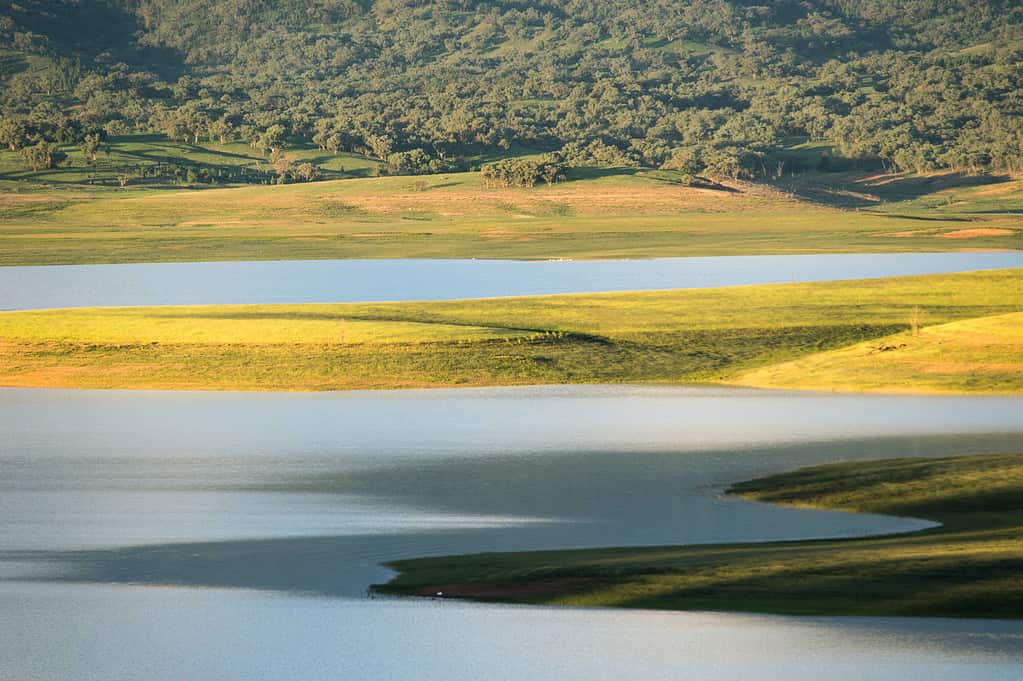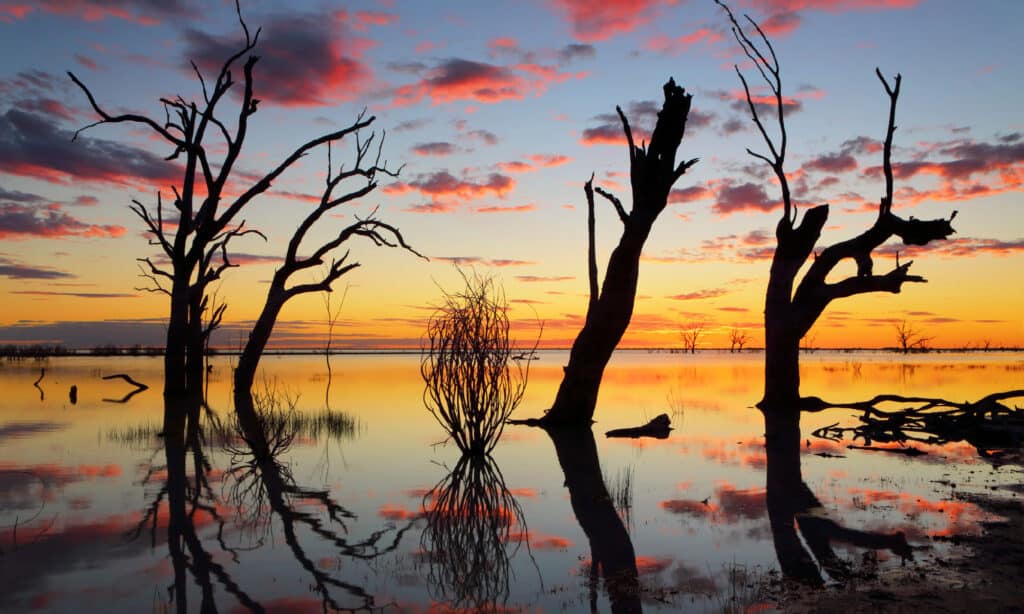Australia is divided into six states and two territories. In the southeast, at 312,528 square miles, is the state of New South Wales. The region is home to gorgeous coastal cities, pristine beaches, the rugged Blue Mountains, outback towns, rainforests, and the iconic bustling capital of Sydney. Aside from the endless miles of ocean shoreline, New South Wales includes a stunning amount of inland sparkling lakes.
Read on to discover the six largest lakes in New South Wales. Note that for this list we did not include coastal lagoons or estuaries of the Coral and Tasman Seas, but chose landlocked lakes.
6. Lake Burrendong — 89 Square Kilometers (34 Square Miles)

Lake Burrendong State Park is a popular spot for water sports and outdoor recreation.
©riksphotography/iStock via Getty Images
A manmade reservoir, Lake Burrendong is fed by the Macquarie and Cudgegong Rivers and Meroo Creek. Surrounded by bushland, Lake Burrendong State Park is a popular spot for swimming, kayaking, water skiing, camping, fishing, and hiking. The park offers many amenities including tent camping, cabins, a swimming pool, a children’s playground, and a skate park. Also, fish in the lake are plentiful and anglers can expect to catch redfin, Murray cod, catfish, and yellow belly.
Unfortunately, the lake is susceptible to drought. In 2019, a drought caused water levels to drop. The water became so low in the lake that the remains of the town that was flooded to create the reservoir began to appear. Old fence posts, steps leading to nowhere, and an old boiler are just some of the items that could be seen appearing from the receding waters. However the low waters were temporary, and today the lake is back up to near full capacity.
5. Lake Victoria — 122 Square Kilometers (47 Square Miles)

The naturally occurring Lake Victoria is seen here photographed by NASA from the International Space Station as it orbited 269 miles above.
©NASA / Public domain – License
This naturally occurring shallow lake is located near the South Australia border. The lake helps to regulate the flow and salinity levels of River Murray. The area has a rich history which was discovered when lake levels were low in 1994. Archeologists found aboriginal artifacts including grindstones, campsites, stone tools, burial sites, and many more. Undoubtedly, the lake was an important site for the Aboriginal people for thousands of years.
A fascinating mystery involving Lake Victoria is the missing case of aircraft and two airmen from the Royal Australian Air Force. During World War II, the Air Force used the lake as a training ground. The training activities resulted in an accident involving six deaths. To this day, two airmen and their aircraft remain unfound, presumably somewhere in the lake bed.
Fishing and boating are not permitted on the lake. However, the nearby Rufus River is a popular spot for anglers, with Murray cod being a common catch.
4. Lake Eucumbene — 145 Square Kilometers (56 Square Miles)

When full, Lake Eucumbene has a capacity of nine times Sydney Harbor.
©Warren Lloyd/Shutterstock.com
The largest manmade lake in South New Wales, Lake Eucumbene, has a surface area of 145 Square Kilometers (56 Square Miles). The capacity of Lake Eucumbene is nine times that of Sydney Harbor. The maximum depth is 33 meters (108 feet).
Constructed in the 1950s by damming the Eucumbene River, the lake was part of the Snowy Mountains Scheme. Moreover, this was a vast hydroelectricity and irrigation project and one of the largest engineering feats ever to occur in Australia.
Today, Lake Eucumbene offers breathtaking natural beauty and plenty of outdoor activities, including trout fishing, boating, kayaking, water skiing, and swimming. The lake is stocked with rainbow and brown trout. Bird watching is also a popular pastime in the area. Some of the many species you may see include black swans, pelicans, and wedge-tailed eagles.
3. Lake George – 150 Square Kilometers (58 Square Miles)

Lake George is an endorheic lake, meaning it appears and disappears depending on rainfall amounts.
©Merrillie/iStock via Getty Images
The lake is known as the mysteriously vanishing lake. Although its disappearing act may surprise visitors, there is a scientific reason behind the phenomenon. The lake is an endorheic basin, which means no rivers or creeks flow out of it. When replenished by rain, the dry basin transforms into a magnificent lake. When the water evaporates or seeps underground, it goes completely dry. Sheep graze in the lake area when the waters are gone.
According to local news, as of 2023, the lake does contain water and should continue to do so throughout the rest of the year. Whether or not the water will remain depends on future rain levels. In the past, anglers stocked the lake with fish during times of high waters. However, this proved to be a disaster in the mid-1800s. A local farmer stocked the lake with Murray cod. The fish grew abundant, but then the lake dried up, killing all of the fish.
Today, tourists enjoy picnicking nearby and viewing the lake bed from the Weereewa Lookout. A nearby winery offers wine made with grapes grown along the edge of the lake.
2. Menindee Lakes — 457 Square Kilometers (176 Square Miles)

The four main lakes of the Menindee Lake system make a combined surface area of 457 kilometers.
©iStock.com/lovleah
The Menindee Lakes is a system of nine wide but shallow lakes fed by the Darling River when it floods. The four main lakes include Lake Wetherell, Lake Pamamaroo, Lake Menindee, and Lake Cawndilla. Together, they make a combined surface area of 457 kilometers (176 square miles), which makes the system the second-largest lake in New South Wales.
Previously, the lakes were ephemeral lakes, meaning they could dry up seasonally if not enough rainfall occurred. Today, the lakes are used for water storage. When they are full they hold three and half times as much water as Sydney Harbour. Fishing is a popular sport at the lakes, and some of the fish commonly caught include silver perch, catfish, European carp, and Murray cod. Other pastimes include sailing, swimming, canoeing, jet skis, and camping along the banks.
The Kinchega National Park surrounds Lake Cawndille and is part of Menindee Lake. At the site of the historic Kinchega Station, today visitors can visit the homestead ruins and tour the historic woolshed and shearer’s quarters. For nearly 100 years, at least six million sheep were sheared in the historic woolshed.
1. Garnpung Lake — 542 Square Kilometers (209 Square Miles)

Lake Mungo National Park in New South Wales is home to spectacular sand and clay dunes.
©DOMENICO STALLO / CC BY-SA 4.0 – License
Located in the Willandra Lakes region of far southwestern New South Wales is the largest lake in New South Wales, however, don’t expect water sports on this lake. Millions of years ago, the lake was full of water. However, it’s been dry for over 10,000 years. Oddly enough, Google Maps hasn’t caught up to the dry nature. When you search for Garnpung Lake, you will see a blue representation on Google.
Within Mungo National Park in the Willandra Lakes Region is one of the world’s most significant archaeological sites. The Willandra Lakes Region was added to the Australian National Heritage List in 2007. The area is rich with evidence of ancient life. It is here that the remains were found of the 40,000-year-old Mungo Lady and Mungo Man. Today, visitors can tour the area and drive through the dry, desert landscape and right across the lake bed that once held sparkling blue waters.
Summary of the 6 Largest Lakes in New South Wales
| Rank | Lake | Size | Top Activities |
|---|---|---|---|
| 1 | Garnpung Lake | 542 Square Kilometers | Hiking, camping, guided tours, self-guided tours |
| 2 | Menindee Lakes | 457 Square Kilometers | Sailing, swimming, fishing, canoeing, jet skies, camping |
| 3 | Lake George | 150 Square Kilometers | Visit the Weereewa Lookout, picnic, or tour a winery |
| 4 | Lake Eucumbene | 145 Square Kilometers | Trout fishing, boating, kayaking, water skiing, swimming |
| 5 | Lake Victoria | 122 Square Kilometers | Picnicking, viewpoint overlooking the lake |
| 6 | Lake Burrendong | 89 Square Kilometeres | Camping, watersports, hiking, fishing |
The photo featured at the top of this post is © iStock.com/lovleah
Thank you for reading! Have some feedback for us? Contact the AZ Animals editorial team.







